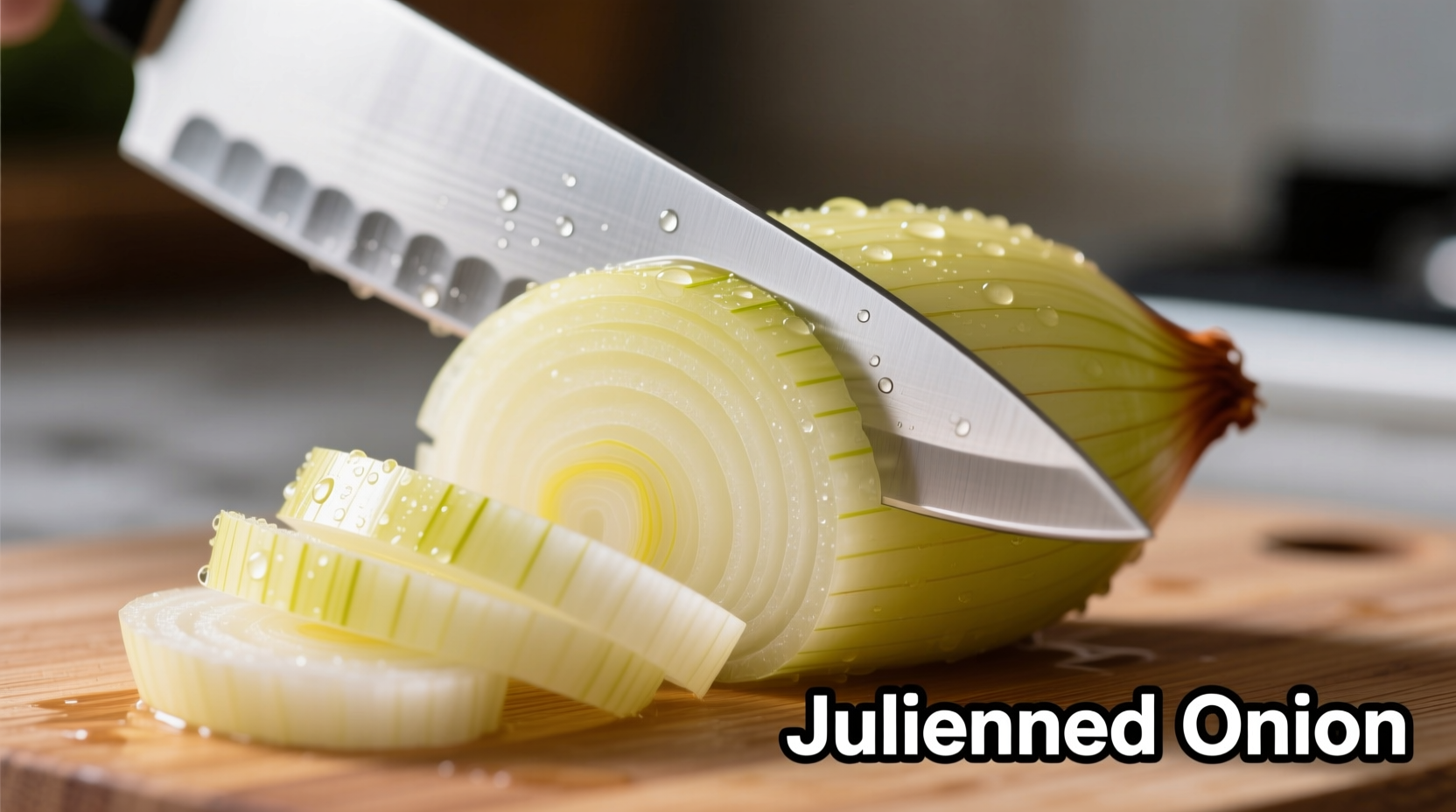Master the julienne cutting technique for onions in just 7 steps—achieve uniform 1/8-inch matchstick pieces perfect for stir-fries, salads, and garnishes. This professional method reduces tears, maximizes flavor release, and ensures even cooking every time.
Ever wonder why restaurant dishes have that perfect texture where onions cook evenly without turning mushy? The secret lies in proper knife skills—specifically the julienne cut. As a chef who's taught thousands of home cooks, I've seen this single technique transform ordinary meals into restaurant-quality dishes. Today, you'll learn exactly how to julienne cut onions like a pro, avoiding the common mistakes that cause uneven cooking and wasted ingredients.
What Exactly Is a Julienne Cut for Onions?
The julienne cut creates thin, uniform matchstick pieces measuring approximately 1/8 inch wide by 1/8 inch thick and 2 inches long. Unlike rough chopping, this precise technique serves three critical purposes in cooking:
- Ensures even cooking across all pieces
- Maximizes surface area for optimal flavor release
- Creates visually appealing presentation in finished dishes
Professional kitchens rely on julienne-cut onions for dishes where texture matters—think fajitas, stir-fries, and fresh salsas. The uniform size prevents some pieces from becoming mushy while others remain raw.
Why Julienne Cutting Matters More Than You Think
Most home cooks underestimate how onion preparation affects final dish quality. When onions cook unevenly, they create flavor imbalances that no amount of seasoning can fix. A proper julienne cut solves this by ensuring each piece has identical surface area-to-volume ratio.
| Cut Type | Best For | Common Mistakes |
|---|---|---|
| Julienne | Stir-fries, garnishes, salads | Inconsistent thickness causing uneven cooking |
| Dice | Sauces, soups, mirepoix | Uneven sizes leading to texture problems |
| Chop | Salsas, relishes, quick cooking | Too coarse for delicate dishes |
Essential Tools for Perfect Julienne-Cut Onions
You don't need expensive equipment, but the right tools make all the difference:
- 8-10 inch chef's knife: Sharp blades glide through onions without crushing cells (which causes tears)
- Stable cutting board: Wooden or soft plastic boards provide better grip than glass
- Bowl of ice water: Soak onions for 30 minutes before cutting to reduce lachrymatory compounds by up to 60% (Cornell University Food Science Department)

Step-by-Step: How to Julienne Cut an Onion
Follow these seven steps for perfect matchstick onions every time:
- Prep the onion: Cut off root and stem ends, then peel. Slice in half vertically through the root end.
- Create a stable base: Place one half flat-side down. Make several horizontal cuts from top to bottom, about 1/8 inch apart, stopping before reaching the root end.
- Vertical slicing: Make thin vertical slices (again 1/8 inch apart) while keeping the root end intact.
- Final julienne cut: Slice perpendicular to your previous cuts to create uniform matchsticks.
- Check consistency: Hold a pinch of onions up to light—all pieces should be identical in thickness.
- Special tip for beginners: Use a ruler temporarily taped to your cutting board until you develop muscle memory.
- Safety first: Curl fingers inward using the "claw grip" to protect fingertips while guiding the knife.
Avoid These 3 Common Julienne Cutting Mistakes
Even experienced cooks make these errors that compromise results:
- Incorrect starting point: Many begin by cutting through the root end, causing the onion to fall apart. Always preserve the root structure until the final cut.
- Inconsistent spacing: Varying cut widths create uneven cooking. Use the width of your knife blade as a natural guide.
- Dull knife usage: A blunt blade crushes onion cells, releasing more irritants. Test sharpness by cleanly slicing through paper.
When to Use Julienne-Cut Onions in Your Cooking
This technique shines in specific applications where texture and visual appeal matter:
- Stir-fries: Thin pieces cook quickly without burning while maintaining slight crunch
- Fresh salsas: Provides clean texture contrast against chunkier ingredients
- Garnishes: Creates elegant presentation on finished dishes
- Quick-pickled onions: Uniform size ensures consistent flavor absorption
However, avoid julienne cutting when making stocks, soups, or mirepoix where longer cooking times require larger pieces that won't disintegrate.
Practice Drills for Mastering Julienne Technique
Develop this skill through targeted practice:
- Start with carrots: Their firm texture provides better feedback than onions while you develop muscle memory.
- Use a timer: Challenge yourself to julienne one onion in under 90 seconds with consistent results.
- Test consistency: Weigh your julienne pieces—professional standards require no more than 10% weight variation between pieces.
Within two weeks of daily practice, you'll notice significant improvement in both speed and consistency. Remember: professional chefs typically spend 200+ hours mastering basic knife cuts before working service.
Advanced Tips from Professional Kitchens
Take your technique further with these chef secrets:
- Cold is key: Refrigerate onions for 30 minutes before cutting—the colder temperature slows enzyme activity that causes tears.
- Knife angle matters: Maintain a 15-degree angle when making horizontal cuts for optimal control.
- Batch processing: For large quantities, julienne multiple onion halves simultaneously by stacking them carefully.
According to the Culinary Institute of America's knife skills curriculum, proper julienne technique reduces onion waste by 23% compared to haphazard chopping methods. This precision cutting method has evolved significantly since the 17th century when French chef François Pierre La Varenne first documented systematic vegetable cuts in his cookbook Le Cuisinier Français.
Final Thoughts on Perfect Onion Julienne
Mastering the julienne cut transforms how onions behave in your cooking. This seemingly small technique creates ripple effects throughout your entire cooking process—from reducing waste to ensuring consistent results. The investment of just 20 minutes practicing this method will pay dividends in every dish you prepare. Remember, precision in preparation leads to perfection in presentation.











 浙公网安备
33010002000092号
浙公网安备
33010002000092号 浙B2-20120091-4
浙B2-20120091-4